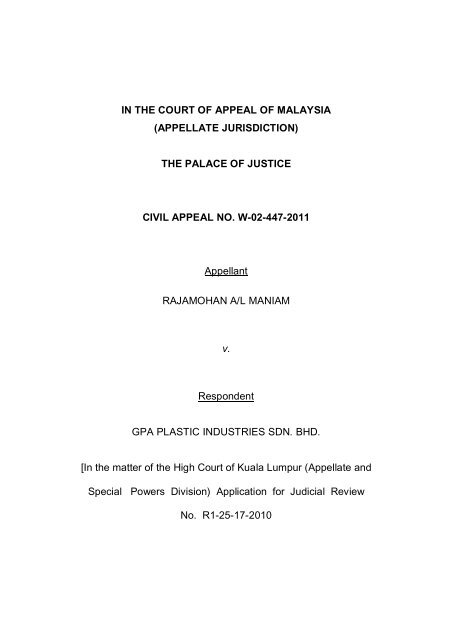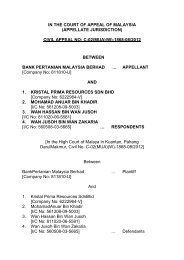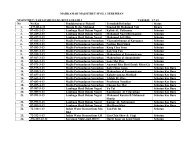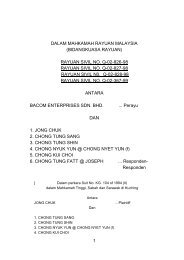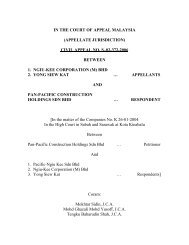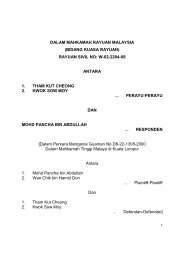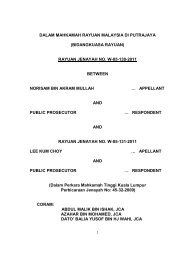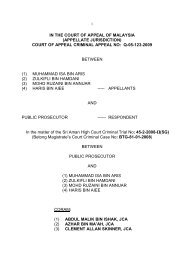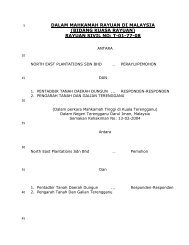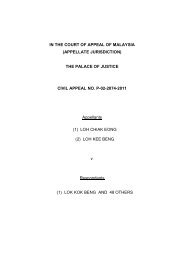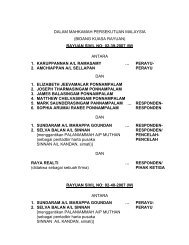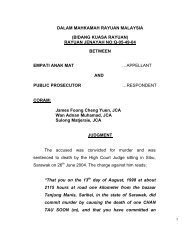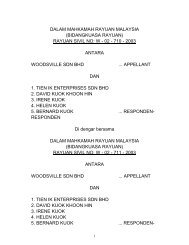IN THE COURT OF APPEAL OF MALAYSIA (APPELLATE ...
IN THE COURT OF APPEAL OF MALAYSIA (APPELLATE ...
IN THE COURT OF APPEAL OF MALAYSIA (APPELLATE ...
You also want an ePaper? Increase the reach of your titles
YUMPU automatically turns print PDFs into web optimized ePapers that Google loves.
<strong>IN</strong> <strong>THE</strong> <strong>COURT</strong> <strong>OF</strong> <strong>APPEAL</strong> <strong>OF</strong> <strong>MALAYSIA</strong><br />
(<strong>APPELLATE</strong> JURISDICTION)<br />
<strong>THE</strong> PALACE <strong>OF</strong> JUSTICE<br />
CIVIL <strong>APPEAL</strong> NO. W-02-447-2011<br />
Appellant<br />
RAJAMOHAN A/L MANIAM<br />
v.<br />
Respondent<br />
GPA PLASTIC <strong>IN</strong>DUSTRIES SDN. BHD.<br />
[In the matter of the High Court of Kuala Lumpur (Appellate and<br />
Special Powers Division) Application for Judicial Review<br />
No. R1-25-17-2010
Applicant<br />
GPA Plastic Industries Sdn. Bhd.<br />
v.<br />
Respondents<br />
(1) Industrial Court, Malaysia<br />
(2) Rajamohan a/l Maniam]<br />
Coram:<br />
Raus Sharif, PCA<br />
Mohd Hishamudin Yunus, JCA<br />
Anantham Kasinather, JCA<br />
JUDGMENT <strong>OF</strong> <strong>THE</strong> <strong>COURT</strong><br />
This is an appeal against the decision of the High Court of Kuala<br />
Lumpur of 25 January 2011.<br />
2
On 25 January 2011 the High Court of Kuala Lumpur (Appellate and<br />
Special Powers Division) had allowed the respondent’s application for<br />
judicial review against the decision of the Industrial Court of 10<br />
December 2009.<br />
Earlier, the Industrial Court, in its award, had allowed the appellant’s<br />
claim for wrongful dismissal. The Industrial Court ruled that the<br />
transfer of the appellant from the post of Plant Executive to the post<br />
of Store Executive amounts to constructive dismissal as well as a<br />
fundamental breach of the appellant’s contract of service with the<br />
respondent company. The Industrial Court, accordingly, awarded the<br />
appellant back wages (in the sum of RM81,240) and compensation in<br />
lieu of reinstatement (in the sum of RM44,005).<br />
Aggrieved by the decision of the Industrial Court, the respondent<br />
company applied to the High Court of Kuala Lumpur for judicial<br />
review pursuant to Order 53 of the Rules of the High Court 1980,<br />
seeking the issuance of a writ of certiorari to quash the award of the<br />
Industrial Court. The application was made on the ground, inter alia,<br />
3
that, on the facts and evidence, no reasonable tribunal would have<br />
arrived at the decision that was made by the Industrial Court.<br />
The High Court allowed the respondent company’s application for<br />
judicial review. The High Court accepted the contention of the learned<br />
counsel for the respondent company that the decision of the Industrial<br />
Court, on the facts and evidence, was unreasonable.<br />
Dissatisfied by the decision of the High Court, the appellant appealed<br />
to this Court.<br />
On 13 October 2011 we unanimously allowed the appeal with costs.<br />
We now give our grounds.<br />
We are of the view that, given the facts and the evidence, there is<br />
nothing unreasonable about the decision of the Industrial Court.<br />
Therefore, there was no basis for judicial review by the High Court.<br />
We shall deal with the facts and the evidence first.<br />
4
The appellant started work with the respondent company as a Plant<br />
Executive in the Production Department on 2 September 1996. The<br />
respondent company was then known as ‘Koaki Plastic Industries<br />
Sdn. Bhd.’. On 1 November 2001 the respondent company changed<br />
its name to ‘GPA Plastic Industries Sdn. Bhd.’ (the current name of<br />
the respondent company).<br />
Towards the end of 2004 there was a vacancy in the post of Store<br />
Supervisor at the Store of the respondent company. The Store<br />
Supervisor was the personnel in charge of the respondent company’s<br />
Store. The management decided to fill the vacancy by transferring the<br />
appellant to the Store as a Store Executive (instead of as a Store<br />
Supervisor). The appellant was informed of the transfer on 26 March<br />
2005. At the meeting of heads of department on 28 March 2005, in<br />
the presence of the appellant, an announcement was made by one<br />
Mr. Er Cheng Guan, the Assistant General Manager, to the effect that<br />
the appellant would be transferred to the Store as a Store Executive<br />
with effect from 1 April 2005. Later, on the same day, the appellant<br />
was issued with the letter of transfer, but he refused to accept it.<br />
5
The appellant was unhappy about the transfer. Although his salary<br />
would remain the same, he felt that it was a demotion. He believes<br />
that there was an ulterior motive for the transfer: it was a subtle<br />
means to remove him from the Production Department and to demote<br />
him; and, ultimately to drive him into resignation. He believes it was<br />
a move engineered by Mr. Er who, by reason of past work-related<br />
incidents involving him and the appellant, had a dislike for the latter.<br />
The appellant felt frustrated and humiliated. He had been in the<br />
Production Department for more than 9 years. He was never familiar<br />
with the work at the Store. At the Production Department he had<br />
around 30 personnel working under him. They include a supervisor, a<br />
production clerk, line leaders, operators, foremen, as well as<br />
maintenance staff; whereas at the Store he would have only three<br />
store hands under him. These store hands are essentially coolies<br />
(manual workers) of foreign nationality. The work at the store would<br />
carry lesser functions and responsibilities. Prior to his appointment as<br />
a Store Executive, the store was never placed under the charge of an<br />
officer of ‘executive’ rank. Previously, the person in charge of the<br />
store was only of the rank of supervisor.<br />
6
According to the appellant –<br />
If I were to go to the store, I will lose all the respect among my fellow<br />
colleagues and employees and it will be very humiliating for me to work in<br />
the store when I had so much power and authority in the production<br />
department. I know the Company purposely did this to frustrate and<br />
victimize me.<br />
But the respondent company disputes this allegation. According to<br />
the evidence of the respondent company –<br />
The Claimant was selected because he had considerable experience in<br />
the Company and his current duties included liaison with the Store.<br />
On 7 April 2005 the appellant wrote to the respondent company<br />
asking the latter to withdraw the transfer order and to reinstate him to<br />
his original post; otherwise he would regard himself as having been<br />
dismissed. According to the concluding part of his letter –<br />
Kindly reinstated my position within 7 days upon receiving this letter.<br />
Otherwise I will terminate myself unwillingly.<br />
7
The respondent company replied to this letter on 9 April 2005<br />
explaining as to why he had to accept the transfer.<br />
The appellant did not report for work with effect from 14 April 2005.<br />
The respondent company wrote to him via a letter dated 18 April<br />
2005 asking him to explain his absence from work, failing which<br />
disciplinary action would be taken against him.<br />
The appellant’s last drawn salary with the respondent company was<br />
RM3,385 per month.<br />
According to the judgment of the Industrial Court –<br />
The onus of proving constructive dismissal lies with the Claimant where he<br />
has to establish his case on a balance of probabilities.<br />
…<br />
The evidence before the Court that the Claimant was transferred from<br />
being Plant Executive in the Production Department to the position of<br />
8
Store Executive effective from 1 April 2005 vide letter dated 28 March<br />
2005 (CO-19) was not disputed.<br />
The Company vide its witness testified that the Claimant was selected<br />
because he had considerable experience in the Company and his current<br />
duties included liaison with the store.<br />
The Court rejects the Company’s argument that the Claimant was not<br />
demoted by the said transfer as his salary remained unchanged.<br />
The Court in fact accepts the Claimant’s argument that the said transfer<br />
was indeed a demotion of himself as it meant that his overall<br />
responsibilities changed. The transfer also meant that the Claimant’s job<br />
scope changed.<br />
There is a dearth of evidence from the Company to show that the<br />
Claimant’s transfer was a lateral one.<br />
The Company submitted that the Claimant did not protest or notify the<br />
Company that he was dissatisfied with the transfer and was therefore<br />
treating himself as being constructively dismissed.<br />
9
The Claimant testified that on 28 March 2005 during the announcement of<br />
his transfer he did not voice out any objection as at the material time there<br />
was no formal letter of transfer and further he elected to remain silent<br />
because of fear of insubordination.<br />
The Claimant considered duties in the store was for less responsible job<br />
and it was an inferior post as compared to those in the production.<br />
The Claimant did issue a letter by hand dated 7 April 2005 requesting the<br />
Company to reinstate him within seven days to his original position or he<br />
will consider himself constructively dismissed.<br />
In the light of the facts and evidence the Court is satisfied that the<br />
Claimant’s transfer from Production Department to the store by the<br />
Company was fundamentally a breach of the Claimant’s contract of<br />
employment and actuated with bad faith. It is my finding based on<br />
evidence and facts that the Company was aware of the Claimant’s<br />
rejection of a new position that was offered to him by the Company.<br />
It is without doubt that the Company had constructively dismissed the<br />
Claimant by demoting him from Production Department to the position of<br />
Store Executive which was an inferior post, and that the Company had no<br />
just cause or excuse to dismiss.<br />
10
As said earlier, the learned High Court Judge granted the application<br />
for the issuance of a writ of certiorari to quash the decision of the<br />
Industrial Court. According to the learned High Court Judge –<br />
[15] The Industrial Court found that the 2 nd Respondent has been<br />
constructively dismissed because his overall responsibilities and job scope<br />
has changed. I find that the Industrial Court has failed to consider whether<br />
on the unchallenged evidence that the Applicant was unable to fill the<br />
vacancy of store executive for five months, the reason for the transfer is<br />
legitimate and whether in the circumstances the conduct of the Applicant<br />
in transferring the 2 nd Respondent to the post of store executive was<br />
conduct which evinced an intention not to be bound by the 2 nd<br />
Respondent’s contract of employment. I find that the Industrial Court has<br />
failed to take into account the testimony of the 2 nd Respondent which<br />
shows the real reason why the 2 nd Respondent refused the transfer. The<br />
Industrial Court has failed to draw the proper inferences from the<br />
unchallenged evidence and/or admitted facts. The Industrial Court has<br />
also failed to consider paragraph 34 of the 2 nd Respondent’s affidavit in<br />
reply wherein he avers that he did not work long in the other company<br />
thus tacitly admitting that he did secure new employment after claiming<br />
constructive dismissal.<br />
11
[16] For the aforementioned reasons I find that no reasonable tribunal<br />
charged with the same facts and evidence would have come to a similar<br />
conclusion as the Industrial Court did in this case. I find that the Industrial<br />
Court has committed errors of law which warrants intervention.<br />
With respect we are unable to agree with the views of the learned<br />
High Court Judge.<br />
We feel that it is appropriate that at the outset we reiterate here as to<br />
what had been said by the Federal Court in Non-metallic Mineral<br />
Products Manufacturing Employees Union & Ors. V. South East<br />
Asia Fire Bricks Sdn. Bhd. [1976] 2 MLJ 67 as to the proper role of<br />
a High Court in hearing a case of judicial review:<br />
The circumstances under which the High Court can interfere with the<br />
decision of the Industrial Court are limited. For instance, it has no<br />
jurisdiction under section 25 of the Courts of Judicature Act to interfere<br />
with the findings of fact reached by the Industrial Court on the ground that<br />
the decision is erroneous except where there is a clear error of law on the<br />
face of the record. It cannot arrogate the powers of a Court of Appeal by<br />
substituting its own judgment for that of the Industrial Court on questions<br />
of fact and cannot review the evidence.<br />
12
On our part, we agree with the Industrial Court: that is, on the facts<br />
and the evidence the transfer was a disguised demotion of the<br />
appellant and a fundamental breach of the appellant’s contract of<br />
employment with the respondent company. We are of the view that it<br />
is obvious from the evidence that there was an ulterior motive for the<br />
transfer, meaning that it was not a bona fide transfer. At the<br />
Production Department the appellant had 30 staff working under him<br />
including a supervisor, a production clerk, line leaders, foremen and<br />
maintenance staff. But at the Store he had only 3 coolies of foreign<br />
nationality working under him. At the Production Department he had<br />
much power and authority, a wider scope of work; whereas at the<br />
Store he would have less functions and responsibilities. Thus, the<br />
post at the Store was an inferior post as compared to the post of a<br />
Plant Executive. Going to the Store would, therefore, be frustrating<br />
and humiliation for him. And there was the strained relationship<br />
between the appellant and Mr. Er, the Assistant General Manager,<br />
who had quite openly shown his strong feeling of dislike for the<br />
appellant; and who had twice suggested to the appellant that the<br />
13
latter should go and work at the Store; and that on the second<br />
occasion the said Mr. Er even said –<br />
Mr. Mohan, you must go to Store otherwise you have no place in<br />
production.<br />
There is also the further evidence of the appellant to this effect –<br />
He further told me that if I myself resign, he will talk to management and<br />
give me compensation of around 14 Months salary, which is better than<br />
labour laws which will give only 9 to 10 months salary.<br />
It is obvious that Mr. Er, as we had said, had a strong dislike for the<br />
appellant and was the personnel behind the transfer.<br />
Our Courts have always held that such disguised demotion amounts<br />
to constructive dismissal; and that it also amounts to a fundamental<br />
breach of contract on the part of the employer entitling the employee<br />
to resign. In Quah Swee Khoon v. Sime Darby Bhd [2001] 1 CLJ 9<br />
Gopal Sri Ram JCA (as he then was) clearly explains the principle (at<br />
p. 19):<br />
14
An employer does not like a workman. He does not want to dismiss him<br />
and face the consequences. He wants to ease the workman out of his<br />
organization. He wants to make the process as painless as possible for<br />
himself. He usually employs the subtlest of means. He may, under the<br />
guise of exercising the management power of transfer, demote the<br />
workman. That is what happened in Wong Chee Hong (ibid).<br />
Alternatively, he may take steps to reduce the workman in rank by giving<br />
him fewer or less prestigious responsibilities than previously held.<br />
Generally speaking, he will make life so unbearable for the workman so as<br />
to drive the latter out of employment. In the normal case, the workman<br />
being unable to tolerate the acts of oppression and victimization will tender<br />
his resignation and leave the employer’s services. The question will then<br />
arise whether such departure is a voluntary resignation or a dismissal in<br />
truth and fact.<br />
It is to be noted that the above passage had referred to the case of<br />
Wong Chee Hong. In Wong Chee Hong v. Cathay Organisation<br />
(M) Sdn Bhd. [1988] 1 MLJ 92 Salleh Abas L. P., in delivering the<br />
unanimous judgment of the Supreme Court, elaborated on the legal<br />
principles (at p. 94):<br />
15
The issue in this appeal is as stated earlier: whether the concept of<br />
constructive dismissal has application to the interpretation of section 20 of<br />
our Industrial Relations Act. Therefore we must know and be clear<br />
precisely in our mind what constructive dismissal is.<br />
In England where this expression originated, there had been a great deal<br />
of unsettled opinions amongst chairmen of industrial tribunals and also<br />
among judges who sat to hear appeals from those tribunals. According to<br />
the Court of Appeal in Western Excavating (ECC) Ltd. v. Sharp [1978]<br />
I.R.L.R. 27, it means no more than the common law right of an employee<br />
to repudiate his contract of service where the conduct of his employer is<br />
such that the latter is guilty of a breach going to the root of the contract or<br />
where he has evinced an intention no longer to be bound by the contract.<br />
In such situations, the employee is entitled to regard himself as being<br />
dismissed and walk out of his employment.<br />
….<br />
Thus in our judgment the transfer, which relegated the applicant to a<br />
position of lesser responsibilities, albeit on the same terms and conditions<br />
of service, which transfer the appellant refused to accept, is a dismissal. It<br />
clearly shows that not only the respondent company was displeased with<br />
the appellant but it also exhibited the respondent company’s intention not<br />
16
to be bound by the contract any longer. Such relegation of responsibility<br />
with its consequent humiliation and frustration and loss of estimation<br />
amongst his fellow employees made it impossible for the appellant to carry<br />
on being employed under the respondent company’s organization. In other<br />
words, he had been driven out of his employment. This is therefore<br />
dismissal. (See Cox v. Philips Industries Ltd. [1975] 1 WLR 638 and J.<br />
F. Bumpus v. Standard Life Assurance Co. Ltd. [1974] IRLR 232).<br />
…<br />
Looking at the award, it is clear to everyone that the Industrial Court in<br />
coming to the conclusion that the appellant was dismissed did not<br />
misdirect itself in law. The court only spoke of constructive dismissal in the<br />
context of the contract test. It never even made any reference to the<br />
unreasonableness test. This is made clear by the following passage at<br />
page 9 of the award:<br />
Past cases of constructive dismissals dealt with by this court … are agreed that<br />
whether or not there has been constructive dismissal is to be determined by the<br />
contract test: that is, did the employer’s conduct amount to a breach of contract<br />
which entitled the employee to resign? And did the employee make up his mind<br />
and act at the appropriate point in time soon after the conduct of which he<br />
complained had taken place.<br />
17
…<br />
We accept this passage to be the correct statement of the law.<br />
On the evidence, the facts and the law, we are of the view that the<br />
learned High Court Judge, with respect, had erred when he held that<br />
the decision of the Industrial Court was unreasonable. On our part,<br />
we hold that, far from being unreasonable, the decision of the<br />
Industrial Court was consistent with the evidence, the facts and the<br />
law. The Industrial Court had correctly evaluated the evidence and<br />
the facts and had applied the contract test. Its decision ought not to<br />
have been disturbed by the High Court on the judicial review<br />
application by the respondent company.<br />
It is, however, the submission of the learned counsel for the<br />
respondent company that the appellant had never considered himself<br />
as being constructively dismissed. It is argued that he left the<br />
respondent company voluntarily; and that the real reason for having<br />
left the respondent company was because the appellant had secured<br />
another higher paying job with a company called Pearl Precision (M)<br />
Sdn. Bhd. in Klang. Learned counsel for the respondent company<br />
18
efers to the letter of offer of a job dated 4 April 2005 addressed to<br />
the appellant from a company called Pearl Precision (M) Sdn. Bhd.<br />
In considering this submission, let us examine what the appellant said<br />
in his evidence –<br />
Q32: Upon your letter seeking reinstatement/constructive dismissal<br />
were you appointed in another company immediately?<br />
A32: I had issued the letter to the Company seeking reinstatement within 7<br />
days or I constructively dismiss myself. As no reply came by 14.4.2005 I<br />
deemed myself dismissed as at 14.4.2005. Around that time I gave the<br />
notice I found out that there is a vacancy for post of Production Manager<br />
in Pearl Precision (M) Sdn. Bhd. based in Pandamaran Jaya, Klang. I was<br />
informed by a person in Pearl Precision that if I am dismissed or<br />
constructively resign from GPA Plastic, then I can join them immediately.<br />
As I received no reply from the Company to my notice during the 7 days<br />
notice period, I joined Pearl Precision around the 15 th or 16 th April 2005 as<br />
Production Manager with salary of RM4,200.<br />
Q33: How long did you work in Pearl Precision?<br />
19
A33: Pearl Precision only paid my wages for the 1 st month of service and<br />
after that they delayed and staggered payment of salary because the<br />
Company was on the verge of bankruptcy. After 3 months working there, I<br />
left the company as they were unable to pay my salary and were closing<br />
down. So, from August 2005 until 2006 I was unemployed. I only managed<br />
to get a job in September 2006 as a Production Executive in Biopro (M)<br />
Sdn. Bhd. in Port Klang with a starting salary of RM1,800 per month and<br />
currently I am still attached here.<br />
Q34: Did you leave GPA Plastic because of this particular new job<br />
waiting for you?<br />
A33: No, that was never ever the reason. I never intended to leave GPA<br />
Plastic except for their conduct in wanting to force me to another lower<br />
department which I don’t have work experience or work knowledge and<br />
humiliating to accept. When I knew that I was constructively dismissed, I<br />
had to take up a job in Pearl Precision although I knew the Company was<br />
on the verge of closing up because I had to sustain myself monetarily as I<br />
have a family to support and many commitments financially.<br />
Having considered the above evidence of the appellant, with respect<br />
we are unable to agree with the respondent’s submission, even<br />
though it is not disputed that the appellant did receive the letter of<br />
20
offer of 4 April. Such a submission is contrary to the evidence of the<br />
appellant as given above, which we think is credible; and, in any<br />
event, had been accepted by the Industrial Court. According to the<br />
appellant, he only started looking for a new job around the time that<br />
he considered himself as having been constructively dismissed. In<br />
fact he joined Pearl Precision only on 15 th or 16 th April 2005, that is to<br />
say, upon the expiration of the 7-days’ notice that he gave to the<br />
respondent company. He did not leave the company voluntarily. He<br />
explained that having considered himself constructively dismissed he<br />
had to look for another job as he had a family to support and had<br />
financial commitments to meet. What the appellant did was what any<br />
reasonable man would have done under the circumstances. In our<br />
judgment it would be a grave injustice to deny the appellant of his<br />
right to consider himself as having been wronged and constructively<br />
dismissed merely on the basis of that letter of 4 April.<br />
In conclusion we set aside the order of the High Court. We restore<br />
the order of the Industrial Court but with a slight variation: that is, a<br />
sum of RM12,600 is to be deducted from the award of back wages as<br />
there is evidence to the effect that upon ceasing employment with the<br />
21
espondent company the appellant was employed for three months at<br />
Pearl Precision (M) Sdn. Bhd. at a salary of RM4,200 per month.<br />
We award costs of RM5000 to the appellant.<br />
[Appeal allowed with costs of RM5,000; Order of the High Court set<br />
aside; Order of Industrial Court restored but varied.]<br />
(DATO’ MOHD HISHAMUD<strong>IN</strong> B<strong>IN</strong> MD YUNUS)<br />
Judge, Court of Appeal<br />
Palace of Justice<br />
Putrajaya<br />
Date of decision: 13 October 2011<br />
Date of written of grounds of judgment: 22 March 2012<br />
Mr. C. V. Devan (Messrs C. V. Devan & Co) for the appellant<br />
Mr. Balan Nair (Messrs Seah Balan Ravi & Co) for the respondent<br />
22


